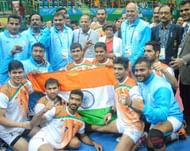What Brazil is to football, Roger Federer is to tennis and Michael Schumacher is to F1, India is to the contact sport of kabaddi. The country has been absolutely peerless in this sport, and the national teams' dominance has been unmatched. No other nation has even come close to India’s staggering success at global and continental meets.
On the men’s side, India have been victorious at each of the seven World Cups, each of the seven Asian Games and also in both the Asian Indoor Games. The women’s national kabaddi team has reigned supreme at all the three World Cups so far as well as the two Asian Games in which the sport has been played.
That itself validates India’s mastery over the sport and the national players' ability to overcome any kind of opposition. And the ongoing Star Sports Pro Kabaddi paints a similar picture of India’s hegemony.
One look at the leaderboard of the tournament will show that every single category is headed by Indian players, despite as many as 26 foreigners from 13 countries participating in the third edition.
Patna Pirates' Pardeep Narwal has been the most spectacular raider this season and has amassed 71 raid points so far. And Puneri Paltan’s talismanic Manjeet Chhillar has been the most outstanding defender and has accounted for 37 successful tackles this season.
Jang Kun Lee is the only foreigner in the top 10 raiders' list, while the best defenders are all Indians.
It was almost the same scenario in the first two editions as well. In Season 2, Kashiling Adake was the most competent raider while Sandeep stood out for his relentless tackles. The first season had the prolific Anup Kumar as the best of the raiders and Manjeet Chhillar was unrivalled in the tackling department.
India’s mind-boggling accomplishments in kabaddi are not without precedent though. It is reported that the sport originated in India as early as 4,000 years ago, and kabaddi has often been mentioned in mythological epics too. The Mahabharata is the most prominent of these, where Abhimanyu was said to have indulged in this sport during his battle with the Kauravas.
Over the years, this indigenous game ingrained itself into India’s culture and became an integral part of the country's sporting ethos. The best thing about it is that it can be played by anyone and doesn’t have any age limit, which surely helped expanding its popularity even further.
Unity in diversity
From Tamil Nadu in the south to Punjab in the north, Bengal in the east to Maharashtra in the west, kabaddi has pervaded throughout India. Today, the sport has so much importance that it has even received the designation of the state sport in many Indian states such as Tamil Nadu, Andhra Pradesh, Telangana and Punjab.
Different forms of the game are practised in the various states. Amar is prevalent in Punjab and Haryana while Huttuttoo is in vogue in Maharashtra. Suranjeevi is the most commonly followed form, and is played in most parts of India as well as globally.
In spite of the slight differences, the essence of this combat sport remains the same in all formats. That is one of the reasons why the national team as well as the Star Sports Pro Kabaddi sees an influx of kabaddi experts from various corners of the nation.
Anup Kumar, who led U Mumba to the title in the second season of the Pro Kabaddi, hails from Haryana. 2014 champions Jaipur Pink Panthers’ skipper Navneet Gautam was born in Rajasthan while Bengal Warriors is led by Nilesh Shinde, a Maharashtra man. This diversity certainly gives a peek into how kabaddi has transcended all regions, and how its nationwide appeal has managed to constantly produce geniuses through the years.
That production line of talent explains why India has had such an iron grip over the elite kabaddi competitions. Experts such as Anup Kumar have been well-versed with the nuances of the game right from their childhood. And that is very obvious when you watch the Indian kabaddi players in action at the ongoing Star Sports Pro Kabaddi.
Nitin Tomar’s speed and acrobatic skills make him one of the most lethal raiders. Manjeet Chhillar’s anticipations skills are next to none. Sandeep Narwal’s stupendous frontal block is one of the prime factors why the Patna Pirates currently sit atop the leaderboard.
The lifelong dedication and innate talent of the Indian kabaddi players are the reason why they are so much better than the rest of the world's players. Their prowess at alternating between ruthless attack and patient defense forms the fundamental core of India’s superiority.
That all-round ability is something that was thoroughly evident at the 2014 Incheon Asian Games, where the Iranian team played some spectacular kabaddi in the summit clash. But the Indian players' calmness and brilliant tactics helped them weather the storm, and their efforts were rewarded with a narrow 27-25 victory.
If there was one thing that stood out in this thrilling match, it was the players’ unflinching passion for the sport. That, surely, will take India to even further heights in the future.

